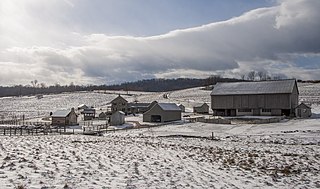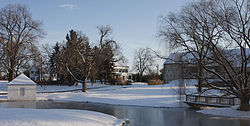
Fort Detrick is a United States Army Futures Command installation located in Frederick, Maryland. Historically, Fort Detrick was the center of the U.S. biological weapons program from 1943 to 1969. Since the discontinuation of that program, it has hosted most elements of the United States biological defense program.

Prospect Hall is a historic mansion, built beginning around 1787 on what was known at the time as "Red Hill", the highest elevation in the area of Frederick, Maryland.

The One-Million-Liter Test Sphere—also known as the Test Sphere, the Horton Test Sphere, the Cloud Study Chamber, Building 527, and the “Eight Ball” —is a decommissioned biological warfare (BW) chamber and testing facility located on Fort Detrick, Maryland, USA. It was constructed and utilized by the U.S. Army Biological Warfare Laboratories as part of its BW research program from 1951 to 1969. It is the largest aerobiology chamber ever constructed and was placed on the National Register of Historic Places in 1977.

St. Paul's Episcopal Church is a parish of the Episcopal Church near Point of Rocks, Frederick County, Maryland, in the Episcopal Diocese of Maryland. It is noted for its historic parish church, a small late Federal style brick structure built in 1842.

Guilford is a large country farmhouse near Frederick, Maryland, built in 1809. Formerly the center of a 103-acre (0.42 km2) farm, the brick house retains many of its outbuildings despite its location in the middle of a suburban shopping and office development.

Spring Bank Farm is a large house, built in 1880 near Frederick, Maryland in the small community of Harmony Grove. The house combines Gothic Revival and Italianate architecture. The house retains much of its historic detailing and interior fabric, as well as a number of outbuildings.

The Nallin Farm Springhouse and Bank Barn are closely associated with the Nallin Farm House on the grounds of Fort Detrick, Maryland, US. The barn is a good example of a fieldstone-built bank barn with a byre on the lower level and an earth ramp on the opposite side providing access to a haymow.

The Brunswick Historic District includes the historic center of the railroad town of Brunswick, Maryland. The district includes the 18th century former town of Berlin, the Baltimore and Ohio Railroad yards along the Potomac River, and the town built between 1890 and 1910 to serve the railroad.
Big Bottom Farm is a farm in Allegany County, Maryland, USA on the National Register of Historic Places. The Greek Revival house was built circa 1845, possibly by John Jacob Smouse, and exhibits a level of historically accurate detailing unusual for the area. The property includes a late 19th-century barn and several frame outbuildings.

The Henry Shoemaker Farmhouse is a circa 1810 Federal style farmhouse which was involved in the Battle of South Mountain in 1862. Located near the eastern end of Turner's Gap, the house was the center of a Union encampment and served as a field hospital.
Edgewood is a historic home located at Frederick, Frederick County, Maryland, United States. It is a two-story multipart limestone farmhouse featuring narrow courses of native stone. The house was constructed and added to over the 18th and 19th century and reflects the Greek Revival style popular at that time. It is associated with the Schley family, prominent 19th century residents of Frederick County, who held the farm from 1830 until 1911.

The James K.P. Wolfe House is a historic home in Frederick, Maryland. It is a two-story, frame, single hall plan, Victorian period farmhouse with Gothic Revival-style detailing. It is a late-19th century example of the Maryland Piedmont farmhouse. The dwelling was built in 1889 by the Wolfe family, who owned the property until 1936.
The Pearre-Metcalfe House is a historic home located at New Windsor, Frederick County, Maryland, United States. It is a brick Greek Revival style farmhouse, built about 1859. There is a small, brick springhouse with corbeled brick cornice and tin roof on the property.

The John Eyler Farmstead is a historic home and farm complex located at Thurmont, Frederick County, Maryland, United States. It includes a two-story, side-passage Flemish bond brick farmhouse with a rear wing built about 1820, a stone springhouse ruin, and a brick silo.

Peter of P. Grossnickel Farm is a historic home and farm complex located at Myersville, Maryland, Frederick County. It consists of a mid-19th-century, Greek Revival farmhouse and 13 related buildings and structures. The house is a 2+1⁄2-story stone center-passage house on a limestone foundation, with a 1+1⁄2-story kitchen wing and 18-inch-thick (460 mm) walls. The house was built between 1840 and 1850. Also on the property is an 1881 tenant house with corresponding barn, spring house, and washhouse / privy; an 1884–1897 bank barn; a pre-1830 granary; a 19th-century wood shed; late-19th-century hog pen / chicken house; a pre-1830 beehive oven; a late-19th-century smokehouse; a spring house with a Late Victorian cottage addition; and early-20th-century concrete block milk house; and a log summer kitchen of unknown date. The Grossnickel family was a German American family who were instrumental in the establishment of the Grossnickel Church of the Brethren.

Harris Farm is a historic home and farm complex located at Walkersville, Frederick County, Maryland, United States. The main house was built in 1855, and is a three-story center plan house in predominantly late Greek Revival syle, with some Italianate elements. The agricultural complex consists of a bank barn with an attached granary; a second frame barn that shares an animal yard with the bank barn; a row of frame outbuildings including a converted garage, a workshop, and a chicken house. There is also a drive-through double corn crib; and a frame pig pen from 1914. The 20th-century buildings consist of a frame poultry house, a dairy barn with milk house and two silos, and an octagonal chicken coop. A lime kiln is located on the edge of the property. The property is preserved as part of the Walkersville Heritage Farm Park.

L'Hermitage Slave Village Archeological Site is an archaeological site near Frederick in Frederick County, Maryland. The location, within the boundaries of Monocacy National Battlefield, was the site of l'Hermitage Plantation, founded about 1793 by the Vincendière family. The Vincendières are believed to have been former Haitian landowners who had fled the Haitian Revolution to the Catholic-leaning state of Maryland. L'Hermitage was notable during its time for its size, brutality and for the large number of slaves on the property.

Todd Farmhouse is a historic home located at Fort Howard, Baltimore County, Maryland, United States. It is a 2+1⁄2-story, brick dwelling that is three bays in width. Although initially of a Federal architecture inspired plan, later Italianate alterations dominate its present exterior appearance. It features a steeply pitched gable roof. Also on the property are several farm buildings and a family cemetery.

Creagerstown is an unincorporated community in Frederick County, Maryland, United States. It is playfully known by its residents as "4 miles from everywhere" because of its situation at 4 miles (6.4 km) from Thurmont, Woodsboro, Rocky Ridge, and Lewistown.
The Henry Smeltzer Farmstead is a historic home and farm complex located near Middletown, Frederick County, Maryland, United States. It includes a two-story six-bay brick farmhouse dating to about 1832, a frame bank barn ruin, and several rusticated concrete block silos. A concrete block slaughter house, weighing house well house and holding pens complete the complex, which was associated in the early and mid-twentieth century with Main's Meats in Middletown. The house is built into the hillside as a "bank house", with its cellar above grade on the south side. The front and rear elevations feature porches across their widths.




















